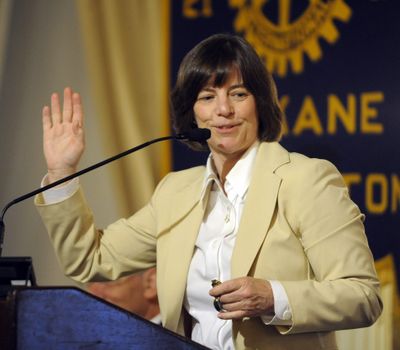Ex-astronaut Dunbar always set sights high

Bonnie Dunbar’s travel photos are a lot more interesting than most.
When the former astronaut showed her family homestead near Sunnyside, Wash., to Spokane’s Rotary 21 club Thursday, the view was from space.
Her slides of the Columbia River, the world’s largest sand dunes in western Africa and the Southern Lights over Antarctica also wowed her audience.
Even the photographic cliché of tourists taking each other’s picture is more interesting on the International Space Station.
Dunbar encouraged her audience to look for the station with help from a National Aeronautics and Space Administration website.
“My 83-year-old mother does that,” Dunbar said.
Her Spokane address had two goals: to generate interest in Seattle Museum of Flight’s efforts to acquire a retired space shuttle, and to “fill the pipeline” of future engineers and scientists.
Dunbar said she was inspired to design spacecraft watching the Sputnik satellite as a 9-year-old on a ranch at Outlook, Wash.
When she entered high school at nearby Sunnyside, the principal told her to take algebra.
“Trust me,” he said, and Dunbar did.
She said she also trusted her physics teacher’s advice to become an engineer. She couldn’t afford to go to the University of Washington, but America’s space program needed engineers and a federal grant paid her way.
At the UW, Dunbar said, the department chairman promised her summer work and introductions to NASA engineers if she would become a ceramics engineer. And she did.
Eventually, she added a doctorate in mechanical and biomedical engineering.
At 28, Dunbar had her “dream job” helping Rockwell International design the space shuttle’s ceramic heat shield. But she joined NASA and participated in five shuttle flights before moving into management.
She trained in Russia for 13 months and learned to speak the language for her final mission, in 1998, in which the Endeavor docked with the Russian space station Mir. Also on that mission was Michael Anderson, of Cheney, who died in 2003 when the Columbia broke up on re-entry.
Dunbar was assistant to the director of the Johnson Space Center when she “jumped” at the chance in 2005 to encourage new generations of engineers through the Museum of Flight.
Engineering graduations in the United States have declined since the ’80s. Ten times as many Chinese and four times as many Indians now become engineers as do Americans, she said.
“The challenge starts in middle school,” Dunbar said.
She said the Museum of Flight reaches 120,000 to 140,000 children a year with 22 programs.
The museum is on a mission to win one of four space shuttles to be retired next year. Dunbar encouraged donations to the project, which she hopes will inspire others as she was.
“Imagine the possibilities of bringing a space shuttle to Washington state on the top of a Boeing 747 that was made in Seattle, and flying it around the Space Needle,” Dunbar said.